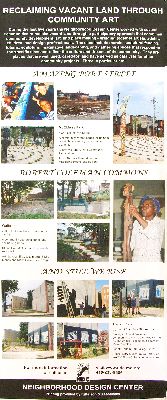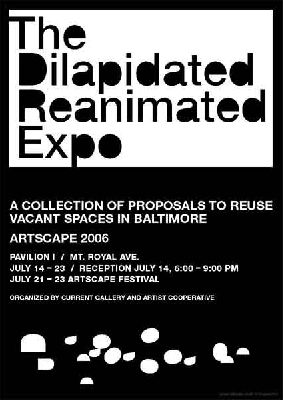Baltimore IMC : http://www.baltimoreimc.org
LOCAL Review :: Baltimore MD : Culture
Re-visioning Baltimore: The Current Gallery Looks at Abandoned Spaces
In a funky, eclectic white tent at Artscape across from the food court, a Baltimore art gallery presented a dozen artistic musings on how to re-think, revise, re-envision and re-use Baltimore's abandoned urban spaces.
The Current Gallery of 30 South Calvert Street presented some fresh and intentionally quirky ideas on how to make life better in American cities in its recent "Dilapidation / Reanimation Expo."
The presentations by over a dozen artists ranged from creating public parks out of vacant lots with each park molded according to an artistic style or thematic goal, to clearing pavement to restore natural ecosystems. One presentation included developing unused waterfronts around big box stores. Another proposed new walking paths that snake across, around, and behind typical urban through-ways.
Since the 1961 book "The Death and Life of Great American Cities" by Jane Jacobs, mainstream urban planning has been considering not just how to build more infrastructure, but also how to potentially repair cities that have been damaged by poor urban planning. Networks of roadways built for cars have retarded and isolated the natural flow of life in neighborhoods with loud, dirty, and dangerous car-busy corridors. Wall-to-wall pavement and concrete in cities has led to ecological thinking about how green spaces can be re-introduced to improve the health of people, animals, and plants. The Current Gallery exhibit used these principals and added one branch to this tree of knowledge, namely also incorporating whimsical and fun design.
In one instance, the brownish commercial park of Port Covington in Baltimore, Maryland was re-envisioned to include a waterside gold course rimming this urban commercial peninsula. The peninsula is a retail space for a large Sam's Club and Wal-Mart, according to a 2004 aerial phone on display. The revision by artists Adam Montegut and Liz Quick called "Topographical Tactics: Ad Hoc Golf: 3s-1e" revived the waterfront area with smooth greens protected by tall, lush trees. Their design also included some boardwalk space directly on the water.
While the idea of creating a public golf course could be serious--or just whimsy--the main point was hard to miss. Society should craft urban spaces that support natural ecosystems and healthy human activities. Otherwise, it is all walls and parking lots.
Another exhibit, called "Reclaiming Vacant Land Through Community Art" by a large collection of artists, featured three public parks that each had been built according to a unique and pleasing design. Each park involved community volunteers in their planning and building, the presentation implied. Photos and text displayed: Before-pictures of vacant lots transformed into funky mini-parks. The artists and community volunteers eschewed cookie-cutter playgrounds and bench areas, and built unique, usable places for their communities.
Celery Park on the 600 block of Port Street was built around the theme of totemic architecture and created "a community space including a labyrinth, totems, signs, and other plantings."
Walbrook Park on the 2000 block of Smallwood became "a community gathering space and sculpture garden."
Harlem Park on the corner of Franklin and Strickler Streets became a park based on a poem of Maya Angelou. The park included a collage-style mural on an adjacent building wall, decorative fencing, and a unique ground design. The ground design featured large blocks of concrete peppered with plantings--not exactly green space, but stylistically interesting.
One presentation called the "Hydration Resuscitation Station" by artists Shipei Wang and Sara Cederberg noted that abandoned rowhomes that are left standing are in fact environmentally damaging, for their concrete structures retard rainwater from being absorbed into the ground. Home-based and street-side sewage systems that rely on water treatment plants could be augmented by natural areas in cities where rainwater can seep into the soil. Water then could feed plant life, filter into underground aquifers, and replenish them.
Wang and Cederberg noted that the ground's absorption of water naturally filters rainwater of some pollutants. Their thesis points to the idea that paving over the natural world, rather than incorporating it in human society, is not just unhealthy but also economically costly through the building and maintenance of industrial support-systems.
"The average lot of a vacant rowhome in Baltimore can collect 870 gallons of rain water a month on average, year round," they wrote. "That's enough to flush 543 toilets, take 33 baths, or pressure wash 3 cars."
Wang and Cederberg proposed a fantastical design that used a half-city-block-large canopy to direct water into a vacant building. The building has been hollowed out and turned into a water re-use station. The water then could be piped nearby for flushing toilets, watering lawns, and other appropriate, non-drinking uses throughout the neighborhood. The design itself looking like a metal, flying green dragon.
Design: Imaginative. Argument: Well done.
Cities such as Portland, Oregon have become famous for implementing livable city planning, and fun designs such as imprinting quotes from American poems on downtown sidewalks. Baltimore City also has been redesigning its downtown core.
The smart growth movement likewise has begun to tackle ecological and social problems in the suburbs. Smart growth theory is trying to rethink, revise, and recreate the U.S. suburban landscape to make it more community-orientated, less energy and car dependent, and less individually isolating.
The "Dilapidation / Reanimation" Artscape expo by the Current Gallery, which has a Web site at www.currentspace.com, added small-scale, small-project ideas to the mix. The presentations were like cool water on that hot Artscape July weekend. They doused visitors with refreshing ideas on how to make city life more livable (again).
Credits: Exhibit poster designed by Post Typography; presentation pieces by artists and supplied by the Current Gallery.
The presentations by over a dozen artists ranged from creating public parks out of vacant lots with each park molded according to an artistic style or thematic goal, to clearing pavement to restore natural ecosystems. One presentation included developing unused waterfronts around big box stores. Another proposed new walking paths that snake across, around, and behind typical urban through-ways.
Since the 1961 book "The Death and Life of Great American Cities" by Jane Jacobs, mainstream urban planning has been considering not just how to build more infrastructure, but also how to potentially repair cities that have been damaged by poor urban planning. Networks of roadways built for cars have retarded and isolated the natural flow of life in neighborhoods with loud, dirty, and dangerous car-busy corridors. Wall-to-wall pavement and concrete in cities has led to ecological thinking about how green spaces can be re-introduced to improve the health of people, animals, and plants. The Current Gallery exhibit used these principals and added one branch to this tree of knowledge, namely also incorporating whimsical and fun design.
In one instance, the brownish commercial park of Port Covington in Baltimore, Maryland was re-envisioned to include a waterside gold course rimming this urban commercial peninsula. The peninsula is a retail space for a large Sam's Club and Wal-Mart, according to a 2004 aerial phone on display. The revision by artists Adam Montegut and Liz Quick called "Topographical Tactics: Ad Hoc Golf: 3s-1e" revived the waterfront area with smooth greens protected by tall, lush trees. Their design also included some boardwalk space directly on the water.
While the idea of creating a public golf course could be serious--or just whimsy--the main point was hard to miss. Society should craft urban spaces that support natural ecosystems and healthy human activities. Otherwise, it is all walls and parking lots.
Another exhibit, called "Reclaiming Vacant Land Through Community Art" by a large collection of artists, featured three public parks that each had been built according to a unique and pleasing design. Each park involved community volunteers in their planning and building, the presentation implied. Photos and text displayed: Before-pictures of vacant lots transformed into funky mini-parks. The artists and community volunteers eschewed cookie-cutter playgrounds and bench areas, and built unique, usable places for their communities.
Celery Park on the 600 block of Port Street was built around the theme of totemic architecture and created "a community space including a labyrinth, totems, signs, and other plantings."
Walbrook Park on the 2000 block of Smallwood became "a community gathering space and sculpture garden."
Harlem Park on the corner of Franklin and Strickler Streets became a park based on a poem of Maya Angelou. The park included a collage-style mural on an adjacent building wall, decorative fencing, and a unique ground design. The ground design featured large blocks of concrete peppered with plantings--not exactly green space, but stylistically interesting.
One presentation called the "Hydration Resuscitation Station" by artists Shipei Wang and Sara Cederberg noted that abandoned rowhomes that are left standing are in fact environmentally damaging, for their concrete structures retard rainwater from being absorbed into the ground. Home-based and street-side sewage systems that rely on water treatment plants could be augmented by natural areas in cities where rainwater can seep into the soil. Water then could feed plant life, filter into underground aquifers, and replenish them.
Wang and Cederberg noted that the ground's absorption of water naturally filters rainwater of some pollutants. Their thesis points to the idea that paving over the natural world, rather than incorporating it in human society, is not just unhealthy but also economically costly through the building and maintenance of industrial support-systems.
"The average lot of a vacant rowhome in Baltimore can collect 870 gallons of rain water a month on average, year round," they wrote. "That's enough to flush 543 toilets, take 33 baths, or pressure wash 3 cars."
Wang and Cederberg proposed a fantastical design that used a half-city-block-large canopy to direct water into a vacant building. The building has been hollowed out and turned into a water re-use station. The water then could be piped nearby for flushing toilets, watering lawns, and other appropriate, non-drinking uses throughout the neighborhood. The design itself looking like a metal, flying green dragon.
Design: Imaginative. Argument: Well done.
Cities such as Portland, Oregon have become famous for implementing livable city planning, and fun designs such as imprinting quotes from American poems on downtown sidewalks. Baltimore City also has been redesigning its downtown core.
The smart growth movement likewise has begun to tackle ecological and social problems in the suburbs. Smart growth theory is trying to rethink, revise, and recreate the U.S. suburban landscape to make it more community-orientated, less energy and car dependent, and less individually isolating.
The "Dilapidation / Reanimation" Artscape expo by the Current Gallery, which has a Web site at www.currentspace.com, added small-scale, small-project ideas to the mix. The presentations were like cool water on that hot Artscape July weekend. They doused visitors with refreshing ideas on how to make city life more livable (again).
Credits: Exhibit poster designed by Post Typography; presentation pieces by artists and supplied by the Current Gallery.
Views
Information
Search
This site made manifest by dadaIMC software




